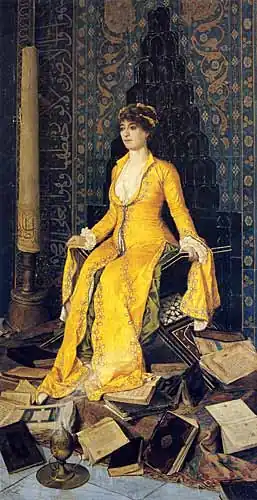Mihrab (painting)
Mihrab (Turkish: Mihrap), also known as Genesis (French: La Genèse)[1] is a 1901 painting by Turkish painter Osman Hamdi Bey.
| Mihrab | |
|---|---|
 | |
| Artist | Osman Hamdi Bey |
| Year | 1901 |
History
The painting was first exhibited in May 1903 at the Royal Academy Exhibition in London under the French name La Genèse, which has been interpreted as a reference to the subject's possible pregnancy. It is unclear if the name came from the organizers or Osman Hamdi Bey himself.[1]
The present location of the painting is unknown.[1]
Description
The painting depicts a woman wearing a bright yellow decollete dress and sitting on a Qur'an lectern. Behind the woman is a tiled mihrab (a niche indicating the direction of the Kaaba in Mecca). On the floor at her feet are several large religious books strewn around.[2] There is an incense burner in the painting's foreground.[3] The identity of the female figure is disputed: it has been variously identified as the painter's wife[4] or his daughter Leyla.[1]
Analysis
The woman is sitting in the Rehal, where the Qur'an is usually placed; she has displaced the Qur'an and is now herself the focus of attention in this painting.[5] The move to a more secular focus is shown by the woman's European dress which contrasts greatly with what would be expected in a mosque.
This painting, like other paintings by Osman Hamdi Bey, comments on the museum culture of his time. All of the items which we see surrounding the woman were part of the Ottoman Imperial Museum's collections. The museum collected religious items but by doing so secularised them,[5] making them into objects which are valued for their aesthetic rather than religious qualities.
The painting has also been seen as blasphemic and anti-Islam, as the woman is trampling over religious books and sitting where the Qur'an should be; as Edhem Eldem says: "it is probably more difficult to imagine a more offensive way of attacking the very foundations of Islamic tradition in the name of promoting female independence and autonomy."[6]
References
- "Mystery of Mihrap Painting - Turkish Forum English". 14 March 2014.
- Denny, Walter B.; Pinar, Salman (January–March 1991). "Review: A History of Turkish Painting". Journal of the American Oriental Society. 111 (1): 165. doi:10.2307/603784. JSTOR 603784.
- Eldem 2012, p. 355.
- Shaw, Wendy (2003-06-12). Possessors and Possessed: Museums, Archaeology, and the Visualization of History in the Late Ottoman Empire. University of California Press. p. 178. ISBN 978-0-520-92856-5.
- Shaw 1999, p. 428.
- Eldem, Edhem. "What's in a name? Osman Hamdi Bey's Genesis" (PDF). Retrieved 24 January 2023.
Sources
- Eldem, Edhem (2012). "Making sense of Osman Hamdi Bey and his paintings". Murnaqas. 29: 339–383. JSTOR 23350369 – via JSTOR.
- Shaw, Wendy (1999). "The Paintings of Osman Handi and the Subversion of Orientalist Vision". In Kafescioğlu, Çiğdem; Thys-Şenocak, Lucienne (eds.). Essays in Honour of Apatullah Kuran. Istanbul. ISBN 975-08-0061-3.
{{cite book}}: CS1 maint: location missing publisher (link)